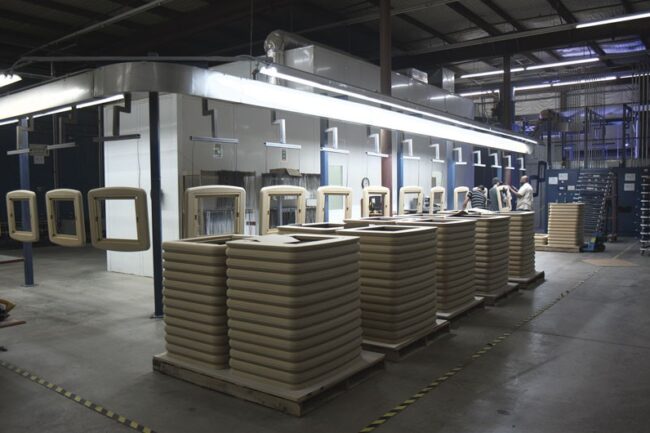Process and Advantages of UV Curing Powders
MDF is easy to process and has a homogeneous and homogeneous surface. Natural wood can also be powder coated, but the finish may be uneven. Problems with outgassing and pinholes may occur due to changes in resin and moisture content in natural wood
The density, fiber, resin and moisture content of natural wood varies by wood type, in addition to the effect of where it is grown, and even if the tree species is the same, every tree is different.
Because the powder coating process uses heat to melt the powder, even at lower temperatures and for short exposure times, heat can cause uncontrollable reactions in natural wood. This makes achieving a uniform surface particularly problematic when powder coatings are applied to natural wood. UV-cured powder coating of MDF produces a more consistent, visually pleasing surface.
UV-curable powder coatings are produced by combining resins, pigments, high performance additives and photoinitiators. Photoinitiators are key components, they absorb high-intensity UV light and generate and activate free radicals to crosslink the coating. Curing is the cross-linking of the entire coating at the molecular level and is an instantaneous curing stage. “As soon as the photoinitiator is exposed to UV light, crosslinking occurs and the coating cures immediately,” said Lonchak.
Additives enhance the coating surface by improving or adjusting specific properties – scratch or mar resistance, gloss and texture. Pigments create color and opacity.
UV-cured powder coatings are produced in the same way as thermoset powder coatings, using the same type of equipment – processes include mixing, extrusion, cooling, slicing, grinding, grading, sieving and packaging.
In order to achieve a good curing effect, it is necessary to match the type and amount of photoinitiator with the UV light source, including the appropriate combination of UV energy dose, intensity and wavelength.
There are several types of medium pressure mercury vapor UV lamps available for UV curing of powder coatings. Mercury lamps (“H” lamps) provide short wavelength (220-320nm) UV energy and are suitable for varnish and clear coat applications. Iron-doped mercury lamps (“D” lamps) provide energy at some longer wavelengths (320-400 nm) to aid in the curing of low pigment content systems. Gallium-doped mercury lamps (“V” bulbs) have strong energy output at long wavelengths (405-440 nm) and are workhorse curing devices for high pigment systems. Long wavelength energy penetrates thicker coatings as well as UV-cured powder coatings of pigmented systems.

MDF initial workpieces are UV cured during powder coating
The process flow for UV-curable powder coatings is fast. “It’s a 20-minute, single-step process that turns an initial MDF part into a finished part, which is then ready to be packaged and shipped,” explains Loncic.
First, the workpiece is hung on the production line, and the dust particles remaining in the process are removed by spraying compressed air. Surface sanding is usually no longer required before powder coating. Next, the MDF workpiece goes into a low temperature preheated oven for one minute. “This vents the sheet before painting and brings the moisture from the MDF to the surface, making the sheet conductive to hold the powder coating,” adds Loncic.
Then, the UV-curable powder coating is electrostatically applied using an automatic spray gun system. The powder is then melted or gelled in a low temperature oven for one minute longer. Once melted, the workpiece solidifies immediately under UV light. In less than 20 minutes, the workpiece is completely machined and ready to be packaged and shipped to the customer.
UV-curable powder coatings were developed more than 20 years ago as an alternative to heat-cured powder coatings. Thermal curing requires high temperatures (about 400°F/204°C) and takes 10-30 minutes or more to complete. Processing time is longer and additional cooling time is required before processing in the next step.
As Lonchak points out, the main advantages of UV curing over thermal curing are in terms of time and temperature. The electrostatic powder coating process for UV-cured powder coatings and thermal-cured powder coatings is exactly the same, however, the melt/flow and curing processes are important different features that functionally differentiate the two.
The UV curing process is instantaneous. It only requires a brief one minute warm-up at 220-240°F (104-116°C) to melt/level the powder coating prior to UV curing. This has the advantage of significantly shortening the process time and lowering the overall temperature, making the UV-curable powder coating process very important in MDF manufacturing. “Excessive heat and exposure time can lead to cracking and other defects in the sheet,” Lonczak noted.
Powder coatings pose some challenges, but DVUV has mastered the measures and means to overcome them. Variations in humidity and temperature can affect the success of a process, but this is easily addressed by operating process control in a temperature-regulated factory. A humidifier ensures that the MDF board maintains the correct moisture level prior to powder coating.
DVUV’s parameter setting and testing at the first run also ensures the production of stable and consistent products. DVUV’s operation of each link is customized according to the customer’s parameter requirements for the workpiece. “Line speed, gun distance and process temperature are different and corrected for each project we run,” concludes Loncic.
In addition to checking during the run to ensure quality, the production team also set up commissioning steps at the same time. Quality control of finished workpieces, including a series of destructive and non-destructive tests:
Visual inspection of workpiece surfaces compared to standard parts
Torque Thickness Gauge Test (Measure Coating Thickness)
gloss reading
MEK Solvent Resistance Test
“Our production teams also have preventive maintenance, traceability analysis and corrective action plans when quality or workmanship issues arise.”
The future is bright for DVUV’s powder-coated MDF. Governments and regulators are restricting or eliminating the use of solvent-based liquid paints.
Waterborne liquid coatings are difficult to use on MDF, which makes UV-curable powder coatings an ideal processing solution for MDF.
UV-curable powder coatings are solvent-free, non-toxic, and contain no volatile organic compounds (VOCs) or harmful air pollutants. Production operations do not require special permission.
